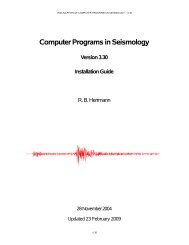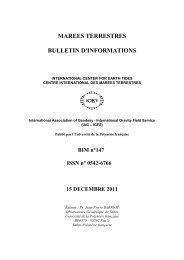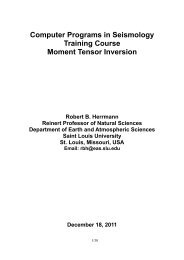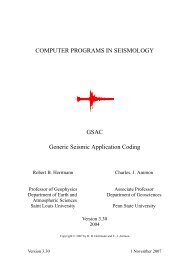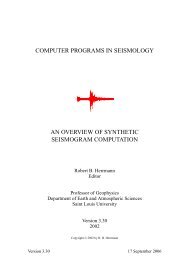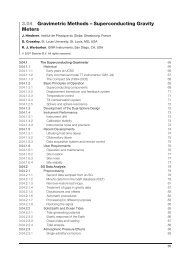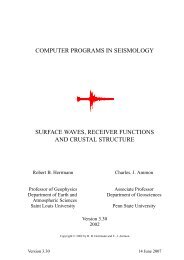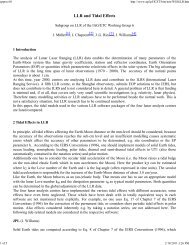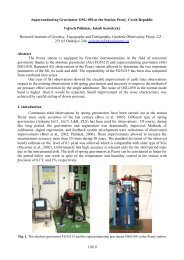Gravity Monitoring with a Superconducting Gravimeter in Vienna
Gravity Monitoring with a Superconducting Gravimeter in Vienna
Gravity Monitoring with a Superconducting Gravimeter in Vienna
You also want an ePaper? Increase the reach of your titles
YUMPU automatically turns print PDFs into web optimized ePapers that Google loves.
Introduction http://www.upf.pf/ICET/bim/text/MEURERS.htm<br />
Introduction<br />
<strong>Gravity</strong> <strong>Monitor<strong>in</strong>g</strong> <strong>with</strong> a <strong>Superconduct<strong>in</strong>g</strong> <strong>Gravimeter</strong> <strong>in</strong> <strong>Vienna</strong><br />
Bruno Meurers<br />
Institute of Meteorology and Geophysics, University of <strong>Vienna</strong><br />
Central Institute of Meteorology and Geodynamics, <strong>Vienna</strong><br />
S<strong>in</strong>ce August 1995 the superconduct<strong>in</strong>g gravimeter GWR C025 is operat<strong>in</strong>g <strong>in</strong> the seismic laboratory of the<br />
Central Institute of Meteorology and Geodynamics <strong>in</strong> <strong>Vienna</strong> (Austria). The laboratory is situated <strong>in</strong> the<br />
basement of the <strong>in</strong>stitute's ma<strong>in</strong> build<strong>in</strong>g where a concrete pillar is founded deeply <strong>in</strong> Alluvial sediments. The<br />
ma<strong>in</strong> goal of research is the determ<strong>in</strong>ation of both tidal and non-tidal gravity variations by comb<strong>in</strong><strong>in</strong>g<br />
cont<strong>in</strong>uous records <strong>with</strong> repeated absolute gravity measurements. The latter will be performed by us<strong>in</strong>g an<br />
upgraded Jila-g type absolute gravimeter. All these <strong>in</strong>vestigations will contribute to the Global Geodynamics<br />
Project (GGP) started <strong>in</strong> July 1997.<br />
The SG gravimeter has been set up at a prelim<strong>in</strong>ary site and will be moved to its f<strong>in</strong>al position at the new<br />
Conrad Observatory that will be constructed 60 km SE of <strong>Vienna</strong> next year. This station is far away from<br />
sources of <strong>in</strong>dustrial noise <strong>in</strong> contrast to the actual site which is situated at the marg<strong>in</strong> of <strong>Vienna</strong>.<br />
Nevertheless, the results obta<strong>in</strong>ed from a 2 years' observation are of high quality. The <strong>in</strong>strument exhibits a<br />
l<strong>in</strong>ear and very small drift of about 30 nms-2 /a only. Therefore, it is especially suited to monitor non-periodic<br />
and long period gravity variations.<br />
The data acquisition is carried out <strong>with</strong> CSGI software (Dunn 1995) runn<strong>in</strong>g on a PC <strong>with</strong> a QNX operat<strong>in</strong>g<br />
system. All data samples are triggered by a GPS time signal. The high resolution gravity output channel<br />
(HR-GRAV) is read by a HP3457A digital multimeter <strong>with</strong> 1 Hz sampl<strong>in</strong>g rate. The air pressure signal is<br />
sampled <strong>with</strong> 0.1 Hz by a Keithley 2000 digital scanner that also monitors <strong>in</strong> one m<strong>in</strong>ute <strong>in</strong>tervals additional<br />
<strong>in</strong>strumental and environmental parameters like the tide filter output signal, two tilt signals, the neck temperatures<br />
at the 11 K and 70 K stage, the room and electronics temperature and the liquid Helium flow rate. S<strong>in</strong>ce<br />
September 1997 a new gravity card (Warburton 1997) is operat<strong>in</strong>g that meets the GGP requirements.<br />
Calibration<br />
The <strong>in</strong>itial calibration has been performed by compar<strong>in</strong>g the filtered gravimeter signal <strong>with</strong> the synthetic earth<br />
tide model of Timmen and Wenzel (1995) <strong>in</strong>clud<strong>in</strong>g the ocean effects. In 1996 the <strong>in</strong>strument has been<br />
calibrated by comparison <strong>with</strong> absolute gravity measurements performed by Jila g-6 (Figure 1). The absolute<br />
gravity has been observed dur<strong>in</strong>g 2.5 days. After elim<strong>in</strong>ation of outliers, about 9000 s<strong>in</strong>gle drops could be<br />
used for the l<strong>in</strong>ear regression analysis. Unfortunately the drop to drop scatter is rather high at the station <strong>in</strong><br />
<strong>Vienna</strong> which limits the calibration accuracy. In addition, the observation period is probably too short to get<br />
1 of 10 2/18/2011 3:30 PM
Introduction http://www.upf.pf/ICET/bim/text/MEURERS.htm<br />
more accurate results (H<strong>in</strong>derer et al. 1997, Francis 1997), but further calibrations could not be performed till<br />
now because of rema<strong>in</strong><strong>in</strong>g <strong>in</strong>strumental problems after servic<strong>in</strong>g and an absolute gravimeter's upgrade. Of<br />
course calibrations will be repeated regularly <strong>in</strong> future.<br />
The <strong>in</strong>itial calibration factor turns out to be correct <strong>with</strong><strong>in</strong> the error band, but because of the high seismic<br />
noise level the accuracy is not better than 0.7%. Additionally the calibration factor is confirmed by compar<strong>in</strong>g<br />
tidal analysis results <strong>with</strong> those obta<strong>in</strong>ed at the same station <strong>in</strong> 1986 (Figure 2) by analyz<strong>in</strong>g a 6 months<br />
observation period of LaCoste-Romberg D-9 (Meurers 1987) equipped <strong>with</strong> an electronic feedback system<br />
SRW-D (Schnüll et al. 1984). The feedback has been calibrated at the precise vertical calibration l<strong>in</strong>e <strong>in</strong><br />
Hannover (Kanngieser et al. 1983). In order to check the temporal stability of the SG's calibration factor<br />
several successive and non-overlapp<strong>in</strong>g data sets cover<strong>in</strong>g a 83 day <strong>in</strong>terval have been <strong>in</strong>vestigated. The<br />
<strong>in</strong>strumental time lag be<strong>in</strong>g changed s<strong>in</strong>ce <strong>in</strong>stallation of the new gravity circuit card has been considered<br />
accord<strong>in</strong>gly. Figure 3 shows the adjusted tidal parameters for the ma<strong>in</strong> tidal waves O1 and M2. The standard<br />
deviation of the amplitude factors amounts for both components 0.0002 only.<br />
Fig. 1: L<strong>in</strong>ear regression analysis of absolute gravity data (Jila g-6) and relative gravity obta<strong>in</strong>ed from GWR C025 (a = regression<br />
coefficient, r = correlation coefficient, n = number of samples).<br />
2 of 10 2/18/2011 3:30 PM
Introduction http://www.upf.pf/ICET/bim/text/MEURERS.htm<br />
Fig. 2: Comparison of tidal parameters obta<strong>in</strong>ed by analyz<strong>in</strong>g 6 months' observation periods from data of LCR D-9 (equipped <strong>with</strong><br />
electronic feedback system SRW-D) and GWR C025. The regression analysis (a = regression coefficient, r = correlation coefficient)<br />
yields same results for <strong>in</strong>dependent GWR time series prov<strong>in</strong>g the time stability of the calibration factor.<br />
Fig. 3: Tidal parameters (O1 and M2) obta<strong>in</strong>ed by analyz<strong>in</strong>g successive non-overlapp<strong>in</strong>g <strong>in</strong>tervals of 83 days each. B: first<br />
observation period, E: last <strong>in</strong>terval, the only one <strong>with</strong> the new gravity card <strong>in</strong>stalled.<br />
3 of 10 2/18/2011 3:30 PM
Introduction http://www.upf.pf/ICET/bim/text/MEURERS.htm<br />
Frequency transfer function<br />
Dur<strong>in</strong>g the <strong>in</strong>stallation of the new gravity circuit card <strong>in</strong> September 1997 the frequency transfer function of<br />
the complete record<strong>in</strong>g system has been determ<strong>in</strong>ed for both the orig<strong>in</strong>al and the new gravity card by apply<strong>in</strong>g<br />
the step response method. The step response data have been analyzed by Wenzel's (1994) program ETSTEP<br />
us<strong>in</strong>g discrete Fourier transform of their time derivative.<br />
Because of the improved filter characteristics of the new card the results are much more sensitive to the<br />
microseismic noise than those of the old gravity card. This is a severe problem at noisy stations like <strong>Vienna</strong>. In<br />
order to reduce the random noise contribution the data of up to 10 s<strong>in</strong>gle steps have been averaged after<br />
detid<strong>in</strong>g. Figure 4 shows the differentiated step response functions of about ten s<strong>in</strong>gle steps and their average<br />
for two experiments performed <strong>with</strong> the old and the new card respectively. Averag<strong>in</strong>g is obviously effective.<br />
However, small amplitude disturbances still rema<strong>in</strong> <strong>in</strong> the case of the new card. Therefore the desired<br />
accuracy of 10 ms could not be obta<strong>in</strong>ed because of the high noise level at the station <strong>in</strong> <strong>Vienna</strong>. Table 1<br />
compares the results of time lag determ<strong>in</strong>ation and the errors <strong>with</strong><strong>in</strong> the tidal band. The statistical evaluation<br />
was done <strong>in</strong> two different ways. First a mean time lag has been calculated us<strong>in</strong>g the results from all s<strong>in</strong>gle<br />
steps <strong>in</strong> upward and downward direction respectively. Afterwards the averaged step response data has been<br />
analyzed separately for each step direction. Table 1 shows that the f<strong>in</strong>al average values of the time lag do not<br />
depend on the evaluation method. The transfer function seems to be well determ<strong>in</strong>ed which is confirmed by<br />
the tidal analysis results. Both the amplitude factors and phases did not change significantly s<strong>in</strong>ce the new<br />
gravity card has been <strong>in</strong>stalled. This is shown <strong>in</strong> Figure 3 where the symbol E marks the results obta<strong>in</strong>ed <strong>with</strong><br />
the new configuration.<br />
Fig. 4: Step response of the record<strong>in</strong>g system <strong>with</strong> the old (left) and the new (right) gravity circuit card. Small disturbances rema<strong>in</strong><br />
after averag<strong>in</strong>g the step response data <strong>in</strong> case of the new card (see details at the top of the graph).<br />
4 of 10 2/18/2011 3:30 PM
Introduction http://www.upf.pf/ICET/bim/text/MEURERS.htm<br />
Tidal analysis and residual determ<strong>in</strong>ation<br />
Tab. 1 : Time lag [s] of the record<strong>in</strong>g <strong>in</strong> the tidal band<br />
Preprocess<strong>in</strong>g and tidal analysis of the raw data sampled <strong>with</strong> 1s <strong>in</strong>terval has been performed by apply<strong>in</strong>g the<br />
ETERNA v3.3 software package of Wenzel (1996) and the programm<strong>in</strong>g module GSOFT of Vauter<strong>in</strong> (1997).<br />
Only a few big disturbances caused by earthquakes had to be removed manually. Also, two manual offset<br />
corrections were necessary <strong>in</strong> order to remove two steps caused by a power supply <strong>in</strong>terruption (190 nms-2 )<br />
and the exchange of the gravity card (-16 nms-2 ) respectively. These step corrections have been determ<strong>in</strong>ed<br />
precisely by adjust<strong>in</strong>g low degree polynomials to small portions of the raw data separately for both sides of<br />
the step. Further, despik<strong>in</strong>g and destepp<strong>in</strong>g has been performed automatically apply<strong>in</strong>g thresholds of 2 and 5<br />
nms-2 respectively for spike and step detection. Intensive test calculations <strong>with</strong> different despik<strong>in</strong>g and<br />
destepp<strong>in</strong>g limits show adjusted tidal parameter to be almost <strong>in</strong>dependent on the thresholds applied. This<br />
justifies the application of automatic preprocess<strong>in</strong>g. With<strong>in</strong> the more than 2 years long observation period<br />
only three small steps (< 40 nms-2 ) have been removed by this automatic procedure.<br />
Table 2 summarizes the analysis results based on the Tamura (1987) tidal potential. The noise estimate of the<br />
amplitude spectrum is less than 0.03 nms-2 <strong>in</strong> the diurnal and less than 0.02 nms-2 <strong>in</strong> the semidiurnal band.<br />
The pressure admittance factor results to -3.538±0.005 nms-2 /hPa.<br />
The procedure of residual calculation starts <strong>with</strong> subtraction of the tidal effect from the hourly data apply<strong>in</strong>g<br />
the same tidal parameters and the same model as obta<strong>in</strong>ed by and adopted for tidal analysis. For these<br />
computations the tidal prediction program supplied by the ETERNA package has been used. The air pressure<br />
effect is removed us<strong>in</strong>g the admittance factor mentioned above.<br />
5 of 10 2/18/2011 3:30 PM
Introduction http://www.upf.pf/ICET/bim/text/MEURERS.htm<br />
Fig. 5: Residuals after subtract<strong>in</strong>g the gravity effect of the adjusted tidal model, the air pressure contribution assum<strong>in</strong>g a frequency<br />
<strong>in</strong>dependent admittance factor and the pole motion effect.<br />
The f<strong>in</strong>al residuals result from remov<strong>in</strong>g the pole motion effect based on IERS data calculated <strong>with</strong>out tak<strong>in</strong>g<br />
6 of 10 2/18/2011 3:30 PM
Introduction http://www.upf.pf/ICET/bim/text/MEURERS.htm<br />
an amplitude factor <strong>in</strong>to account. The residuals are characterized by a very small and l<strong>in</strong>ear drift of about 30<br />
nms-2 /a. Even immediately after <strong>in</strong>strumental set up there is no exponential drift behavior. Figure 5 demonstrates<br />
the different steps and the result of residual calculation.<br />
The residuals are clearly correlated <strong>with</strong> the air pressure because of the dependency of the pressure<br />
admittance function on frequency. Figure 6 presents <strong>in</strong> more detail the hourly residuals after remov<strong>in</strong>g a<br />
l<strong>in</strong>ear drift and the air pressure effect calculated <strong>with</strong> the frequency <strong>in</strong>dependent pressure admittance factor<br />
derived from tidal analysis. A dist<strong>in</strong>ct anti-correlation can be observed prov<strong>in</strong>g the assumed admittance factor<br />
to be too high <strong>in</strong> the frequency range below 1 cpd. This anti-correlation is clearly visible also <strong>in</strong> the long<br />
period components fitted by high degree polynomials. A frequency dependent pressure admittance function<br />
(Figure 7) has been calculated by apply<strong>in</strong>g standard methods (e.g. Neumeyer and Pflug 1997).<br />
Performance control<br />
Tab. 2: Tidal parameters obta<strong>in</strong>ed by analyz<strong>in</strong>g the GWR C025 data between 1995 08 01 and 1997 11 16.<br />
The performance of the SG gravimeter was permanently controlled by monitor<strong>in</strong>g some additional<br />
<strong>in</strong>strumental and environmental parameters like the electronics and room temperature, the temperatures at the<br />
11 K and 70 K stages and the liquid Helium loss rate. The correspond<strong>in</strong>g time series were compared <strong>with</strong> the<br />
hourly residuals <strong>in</strong> order to detect <strong>in</strong>strumental effects <strong>in</strong> the gravity signal. No significant correlation could<br />
be found.<br />
7 of 10 2/18/2011 3:30 PM
Introduction http://www.upf.pf/ICET/bim/text/MEURERS.htm<br />
Fig. 6: Comparison of the trend reduced residuals <strong>with</strong> the observed air pressure show<strong>in</strong>g the frequency dependency of the air<br />
pressure admittance function. Air pressure and residuals are dist<strong>in</strong>ctly anti-correlated <strong>in</strong> the frequency band < 1 cpd.<br />
8 of 10 2/18/2011 3:30 PM
Introduction http://www.upf.pf/ICET/bim/text/MEURERS.htm<br />
Fig. 7: Air pressure admittance function obta<strong>in</strong>ed by averag<strong>in</strong>g over the whole observation period. The method of Neumeyer and<br />
Pflug (1997) has been applied.<br />
Additionally the differences between the signals of the GWR air pressure sensor and an external high quality<br />
sensor implemented <strong>in</strong> a semi-automatic climate monitor<strong>in</strong>g station (TAWES) at the site <strong>in</strong> <strong>Vienna</strong> have been<br />
<strong>in</strong>vestigated. A dist<strong>in</strong>ct correlation <strong>with</strong> the room temperature could be observed prov<strong>in</strong>g the GWR air<br />
pressure sensor be<strong>in</strong>g not accurate and stable enough. The differences are of the order of 1-2 hPa. These<br />
<strong>in</strong>stabilities consequently <strong>in</strong>troduce errors of about 3-6 nms-2 when remov<strong>in</strong>g the air pressure effect for<br />
residual determ<strong>in</strong>ation.<br />
Conclusion<br />
The GWR C025 superconduct<strong>in</strong>g gravimeter has proven to be an excellent <strong>in</strong>strument for monitor<strong>in</strong>g tidal<br />
and non-tidal gravity variations. The drift behavior is almost l<strong>in</strong>ear <strong>with</strong> a small drift rate of 30 nms-2 .<br />
Analyz<strong>in</strong>g successive and <strong>in</strong>dependent time series of about 3 month period shows the high temporal stability<br />
of the <strong>in</strong>strument. The residuals can be expla<strong>in</strong>ed ma<strong>in</strong>ly by air pressure effects that rema<strong>in</strong> when a frequency<br />
<strong>in</strong>dependent admittance factor obta<strong>in</strong>ed from tidal analysis is applied for air pressure correction. In spite of<br />
the high noise level at the station <strong>in</strong> <strong>Vienna</strong> the frequency transfer function of the complete record<strong>in</strong>g system<br />
could be determ<strong>in</strong>ed successfully by the step response method for both the orig<strong>in</strong>al and the new gravity card<br />
recommended for GGP. The <strong>in</strong>terpretation of non tidal phenomena will be supported by comb<strong>in</strong><strong>in</strong>g the<br />
cont<strong>in</strong>uous record <strong>with</strong> regularly performed absolute gravity measurements.<br />
References<br />
Dunn, B., 1995: CSGI software reference manual. Dept. Earth Sciences, University of Western Ontario,<br />
Canada.<br />
Francis, O., 1997: Calibration of the C021 superconduct<strong>in</strong>g gravimeter <strong>in</strong> Membach (Belgium) us<strong>in</strong>g absolute<br />
9 of 10 2/18/2011 3:30 PM
Introduction http://www.upf.pf/ICET/bim/text/MEURERS.htm<br />
gravity measurements. 13 th International Symposium on Earth Tides, Brussels.<br />
H<strong>in</strong>derer, J., Amalvict, M., Francis, O. and Maek<strong>in</strong>en, J., 1997: On the calibration of superconduct<strong>in</strong>g<br />
gravimeters <strong>with</strong> the help of absolute gravimeters. 13 th International Symposium on Earth Tides, Brussels.<br />
Kanngieser, E., Kummer, K., Torge, W. and Wenzel, H.G., 1983: Das <strong>Gravimeter</strong>-Eichsystem Hannover.<br />
Wiss. Arb. Fachrichtung Vermessungswesen, Univ. Hannover, 120.<br />
Meurers, B., 1987: Comparison of Earth Tide Observations <strong>in</strong> <strong>Vienna</strong>. Bullet<strong>in</strong> d'Informations Mareés<br />
Terrestres, 100, 6942-6953.<br />
Neumeyer, J. and Pflug, H., 1997: ADMITT - a program for determ<strong>in</strong>ation of the atmospheric pressure<br />
admittance. Bullet<strong>in</strong> d'Informations Mareés Terrestres, 127, 9851-9855.<br />
Schnüll, M., R.H. Röder and H.-G. Wenzel, 1984: An improved electronic feedback for LaCoste-Romberg<br />
gravity meters. BGI, Bullet<strong>in</strong> d'Information, 55, 27-36.<br />
Tamura, Y., 1987: A harmonic development of the tide-generat<strong>in</strong>g potential. Bullet<strong>in</strong> d'Informations Mareés<br />
Terrestres, 99, 6813-6855.<br />
Timmen, L. and Wenzel, H.G., 1995: Worldwide synthetic gravity tide parameters. In: Sünkel, H., Marson, I.,<br />
(eds): <strong>Gravity</strong> and Geoid. IAG Symposium 113, Spr<strong>in</strong>ger Verlag, 92-101.<br />
Vauter<strong>in</strong>, P., 1997: Graphical <strong>in</strong>teractive software for the analysis of earth tide <strong>in</strong>formation. 13 th International<br />
Symposium on Earth Tides, Brussels.<br />
Warburton, R., 1997: GWR developments. 1 st GGP Workshop, 21 July 1997, Brussels.<br />
Wenzel, H.-G., 1994: Accurate <strong>in</strong>strumental phase lag determ<strong>in</strong>ation for feedback gravimeters. Bullet<strong>in</strong><br />
d'Informations, Marees Terrestres, 118, 8735-8752.<br />
Wenzel, H.-G., 1996: The nanogal software: Earth tide data process<strong>in</strong>g package ETERNA 3.30. Bullet<strong>in</strong><br />
d'Informations Mareés Terrestres, vol. 124, 9425-9439.<br />
Acknowledgement<br />
The author wishes to thank P. Melichar (head of Dept.), N. Blaumoser, M. Göschke, S. Haden and R. Ste<strong>in</strong>er<br />
from the Geophysical Department of the Central Institute of Meteorology and Geodynamics <strong>in</strong> <strong>Vienna</strong> for<br />
their cooperation. Also, all technical support <strong>in</strong> SG <strong>in</strong>stallation and ma<strong>in</strong>tenance by E. Br<strong>in</strong>ton (GWR<br />
Instruments, Inc.) and all efforts of D. Ruess (Federal Office of Survey<strong>in</strong>g, <strong>Vienna</strong>) perform<strong>in</strong>g the absolute<br />
gravity measurements are gratefully acknowledged.<br />
10 of 10 2/18/2011 3:30 PM




